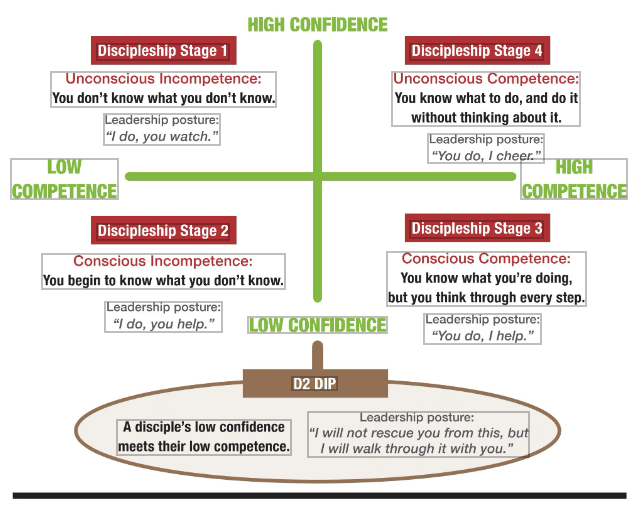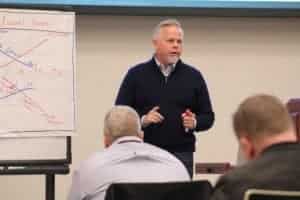leadership expert dave rhodes on the future of the church
The future of the church was never dependent on it getting bigger, said Dave Rhodes of Future Church Co. And it won’t be during the church’s recovery.
Our primary problem as church leaders, he said, is that “too often we are faking disciples instead of making disciples. We become slaves to the ‘functional’ Great Commission: Go into the world and make more worship attenders, baptizing them in the name of small groups and teaching them to volunteer one or two hours a month.”
The leadership consultant and pastor spoke at the 2021 Illinois Leadership Summit, a two-day, multi-site meeting of Illinois pastors and ministry leaders. Rhodes called them to a renewed vision of discipleship for the church’s next chapter.
Making the necessary shift to a more urgent call to discipleship won’t happen through usual assimilation patterns, largely stalled amid shutdowns and interruptions. Instead, Rhodes outlined “five big moves” to create the future church.
1. Move the finish line
Too many churchgoers become stuck in what Rhodes calls the “lower room” of a church. It’s made up of the things that attract people to the church, and it’s a great place to start. The problem comes when people don’t move to the “upper room” that is focused on purpose. The future of the church, Rhodes said, is built on creating a staircase between the two.
To shepherd their people to the upper room, he said, leaders must “move the finish line” from regular assimilation patterns like small group attendance and volunteer service, to participation in the ultimate purpose of the church—making more disciples. Too often, Rhodes said, we’ve created a false finish line: Is someone connected to our church and are they serving? But the future church depends on a new finish line: Does the believer know who they’re called to be? Are they living that out in their 9 to 5, and making their ultimate contribution to the world?
2. Become a hero maker
The second big move is for the church’s senior leadership team, and requires a leader to transition from hero to hero maker. Every great story has both. To create the future church, leaders can’t simply be the heroes everyone applauds. They have to look at everyone in the church and recognize each has a sphere of influence—the group of 20 or 30 or 100 people Rhodes calls the “crowd cloud.”
Even if only 25 people are attending a church, Rhodes said, they may represent 2,500 people on which they have impact or potential influence. Being a hero maker means recognizing a disciple’s potential to reach those people. He told the story of a high-level executive whose church didn’t know how to fit her into its normal assimilation patterns. But she committed to be a gospel light for the hundreds of people she encountered in her workplace— her crowd cloud.
Most churches operate with an assimilation funnel, Rhodes said, that moves people from attending to connecting to serving. The future church depends on forging a multiplication funnel that sends disciples out to make more disciples. When a leader is focused on multiplying disciples, Rhodes said, “we go from simply being the hero of our church that performs goods and services that people can consume, to becoming the hero makers that look at them and see what they could be, that see the God dream on their life.” Helping disciples activate the crowd cloud makes more disciples, and expands the gospel-sharing potential of the church.
3. Build a training center
Rhodes described every disciple’s journey as happening in four stages. Inspired by Ken Blanchard’s “Situational Leadership,” the phases are based on their levels of confidence and competence, and each one requires a different posture from the leader who is shepherding them through the process (see chart on page 13).
Leaving people in the first stages of discipleship means that churches will create loyal listeners, but not learning leaders. That’s why moving disciples from one phase to the next, from unconscious incompetence to unconscious competence, is so crucial. Of course, it’s not always easy. He warned leaders about the “D2 dip,” where disciples experience low confidence and low competence at the same time. But it’s actually a goldmine, Rhodes said.
“Everything they need for the rest of the journey is in that mine,” he said. A leader’s responsibility is to walk with the disciple through it, lending time, vision, and grace to the process.
4. Empower each one Create the future.
If the journey from unconscious incompetence to unconscious competence changes a disciple’s expectation, the next move changes their opportunity. Every person has a kingdom platform. It’s a leader’s responsibility to equip them not just as disciples, but as leaders themselves who are easy to follow and ready to make their ultimate contribution in the world.
This big move expands the reach of the church so that the congregation doesn’t just happen inside the building, but in homes and workplaces, making each a potential “micro-site” of the church. The goal is to recognize every disciple as “a pastor of a parish waiting to be declared,” Rhodes said.
5. Create the future
This is the big move where a church declares its mission and develops language that invites people into that mission. By asking five clarifying questions—what, why, how, when, where—churches avoid getting stuck in the way things have always been. Instead, they articulate a future focused on discipleship, training, and empowering leaders.
Leaders create culture and words create worlds, Rhodes said. “It’s the language we use that creates the world we step into. How do we fight for that language, so that our organizations don’t get stuck in just producing what we’ve always produced, but instead through things like mission and values and strategies and mission measures and visionary plans, we articulate a future that includes the multiplication funnel and begins to normalize that in our congregations?”
Leaders can’t accomplish all five big moves at once, Rhodes said, and there’s no silver bullet. But these five big moves can help the future church emerge. Which one will you consider next? Rhodes asked Illinois leaders. “Which transition would begin to help you shape the future?”
INTERACTIVE: MEASURING PLAYERS’ CONFIDENCE
Based on Ken Blanchard’s “Situational Leadership,” Dave Rhodes’s 4 Phases of Discipleship describe how a Christian can move from incompetence to competence in ministry. Each phase defines a specific posture the individual disciple takes during the stage. And he tells how leaders can relate to them in each stage to help them move to the next.
Stages 2 and 3 are divided by a dip Rhodes says is crucial for both the disciple and the leader. The disciple’s realization of his own incompetence in compounded by the loss of confidence it brings.
The leader must resist being a rescuer in that moment, but not abandon the downbeat disciple to his own failings. A positive upturn is just ahead.
Ask your team:
What stage are you in? How do you recognize it? What are the biggest obstacles to moving on to the next stage? Have you experienced the D2 Dip? Describe what happened. What leaders have had the biggest impact on your discipleship journey? Why?


By Dave Rhodes
Dave is the Co-Founder of Clarity House and the Strategic Director for the Grace Family of Churches headquartered in Atlanta, GA.
